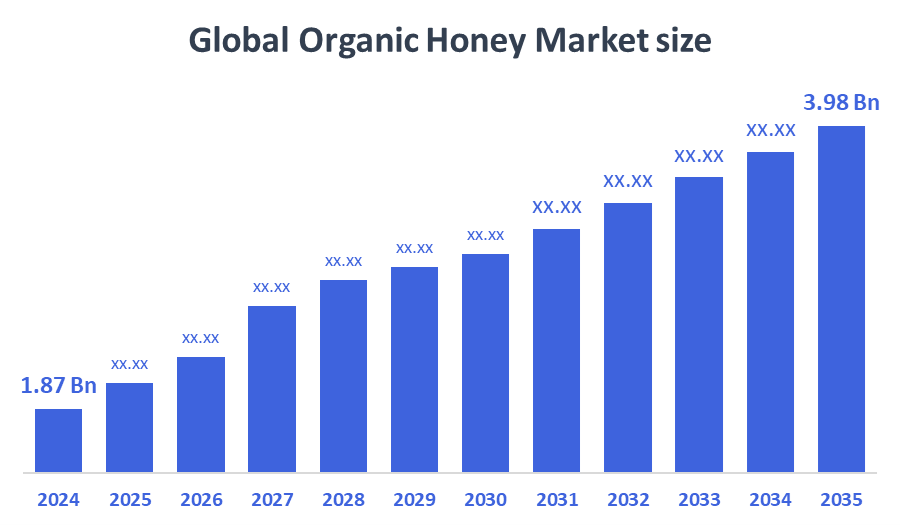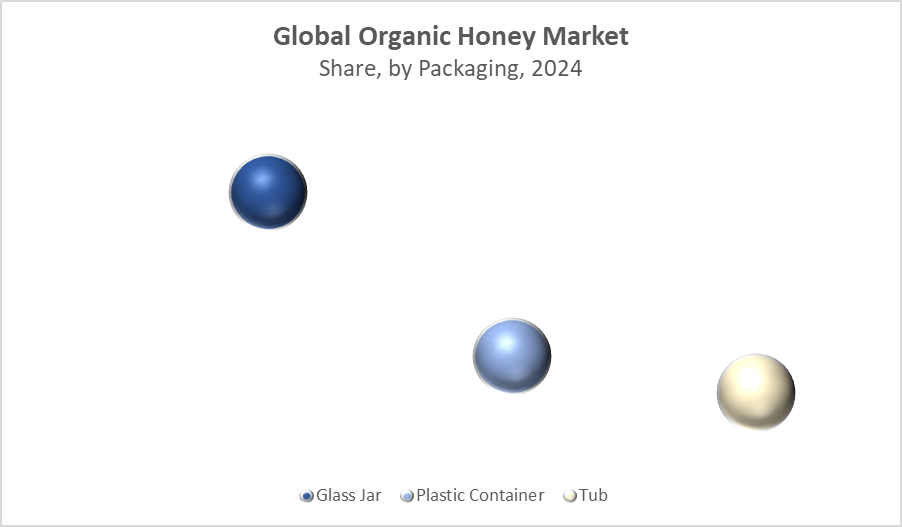Global Organic Honey Market
Global Organic Honey Market Size, Share, and COVID-19 Impact Analysis, Impact of Tariff and Trade War Analysis, By Type (Raw Organic Honey and Processed Organic Honey), By Packaging (Glass Jar, Plastic Container, and Tub), and By Region (North America, Europe, Asia-Pacific, Latin America, Middle East, and Africa), Analysis and Forecast 2025 - 2035
Report Overview
Table of Contents
Organic Honey Market Summary, Size & Emerging Trends
According to Decision Advisor, The Global Organic Honey Market Size is Expected to Grow from USD 1.87 Billion in 2024 to USD 3.98 Billion by 2035, at a CAGR of 7.11% during the forecast period 2025-2035. Increasing consumer preference for chemical-free and natural sweeteners is a key driving factor for the organic honey market.

Key Market Insights
- Europe is expected to account for the largest share in the organic honey market during the forecast period.
- Raw organic honey dominated the market by type due to increasing consumer demand for minimally processed products.
- Glass jar packaging remains the most preferred option due to better preservation and eco-friendly appeal.
Global Market Forecast and Revenue Outlook
- 2024 Market Size: USD 1.87 Billion
- 2035 Projected Market Size: USD 3.98 Billion
- CAGR (2025-2035): 7.11%
- Europe: Largest market in 2024
- Asia Pacific: Fastest growing market
Organic Honey Market
The organic honey market revolves around the production and distribution of honey harvested from bees that are not exposed to pesticides, antibiotics, or artificial additives. It caters to health-conscious consumers seeking natural sweeteners and functional foods. With rising awareness of organic farming and clean-label products, organic honey is increasingly used in culinary applications, skincare, nutraceuticals, and beverages. Regulations around organic certification and sustainability practices are reinforcing market credibility. Supportive government policies, especially in the EU and North America, are fostering organic farming practices, while growing adoption of e-commerce is expanding market reach. Consumers are also showing a willingness to pay premium prices for authenticity and traceability, boosting revenues for ethical and sustainable producers.
Organic Honey Market Trends
- Growing demand for clean-label products is pushing manufacturers toward certified organic sourcing and transparency.
- E-commerce and direct-to-consumer (D2C) brands are gaining momentum as digital platforms enhance access to niche organic offerings.
- Organic skincare and cosmetic brands are increasingly incorporating organic honey due to its antimicrobial and moisturizing properties.
- Artisanal and local honey producers are expanding globally through online retail and social media marketing.
Organic Honey Market Dynamics
Driving Factors: Shift toward natural sweeteners and holistic wellness
The key drivers of the organic honey market include growing health awareness, rising concerns over synthetic additives, and the popularity of functional foods. Consumers are replacing refined sugars with natural alternatives like honey due to its antioxidant and antibacterial properties. Increased use in dietary supplements, wellness teas, and skincare has broadened demand. Moreover, eco-conscious purchasing behaviors and sustainable farming movements are further accelerating the adoption of certified organic products globally.
Restrain Factors: High pricing and supply chain complexity
Key restraints include high production costs due to limited yield per hive and stringent organic certification processes. Organic honey typically commands a premium price, which may deter cost-sensitive consumers. Furthermore, fragmented supply chains and risks of adulteration challenge consumer trust and product authenticity, especially in developing markets.
Opportunity: Expansion of functional food and personal care segments
The organic honey market presents significant opportunities in the nutraceutical and natural personal care segments. Rising use in immunity-boosting products, organic cough syrups, and herbal remedies is creating new revenue streams. Additionally, innovation in sustainable packaging and the rising adoption of organic beauty products open new avenues. Companies investing in traceability and blockchain-based certification can differentiate and lead in premium market segments.
Challenges: Regulatory hurdles and counterfeit risks
Challenges include meeting varied and strict organic standards across regions (e.g., USDA, EU Organic), which complicates export-import logistics. Counterfeit and adulterated honey in the supply chain remains a major issue, leading to consumer skepticism. Climatic conditions, bee health concerns, and seasonal fluctuations also impact production consistency.
Global Organic Honey Market Ecosystem Analysis
The organic honey market ecosystem includes certified organic beekeepers, honey processors, certification agencies (USDA Organic, EU Organic), distributors, online marketplaces, and end-users in food, beverage, pharma, and cosmetics sectors. Key players collaborate with local farmers and invest in sustainability, transparency, and traceability. Retailers and e-commerce platforms play a pivotal role in educating consumers and expanding access. Regulatory bodies drive compliance and boost consumer confidence in certified organic products. Growth is increasingly reliant on digital distribution, innovation, and environmentally responsible practices.
Global Organic Honey Market, By Type
Raw organic honey is honey that is harvested directly from organically raised bee colonies and remains unfiltered, unheated, and unpasteurized. Because it undergoes minimal processing, it retains most of its natural nutrients, including enzymes, antioxidants, vitamins, and antibacterial compounds. This gives it a cloudy appearance and a tendency to crystallize over time, which is often seen as a mark of authenticity. Raw organic honey is especially popular among health-conscious consumers who prioritize clean-label and natural products. It is widely used in wellness routines, functional foods, natural remedies, and even DIY skincare due to its therapeutic properties.
Processed organic honey, while still sourced from certified organic farms, undergoes additional steps such as filtration and light heating to improve its appearance, consistency, and shelf stability. This process removes wax particles and impurities, resulting in a clearer and smoother texture that appeals to a wider consumer base. Although it may lose some of the raw honey’s nutritional value during processing, it is favored in commercial and industrial applications where uniformity and extended shelf life are critical. Processed organic honey is commonly used in packaged food products, beverages, and large-scale retail due to its convenient handling and consistent quality.
Global Organic Honey Market, By Packaging
Glass jar packaging has led the organic honey market because of its eco-friendly and sustainable nature. Being reusable and recyclable, glass aligns well with the values of environmentally conscious consumers and the organic branding ethos. Additionally, glass is non-reactive, which means it does not alter the taste or quality of honey, helping to preserve its natural flavor and nutritional properties. Its premium look and feel also appeal to buyers seeking high-quality and authentic organic products. These advantages have made glass jars the preferred choice for packaging organic honey, especially in niche and premium market segments.

Plastic containers continue to hold a significant share in the organic honey market due to their convenience, lightweight nature, and cost-effectiveness. They are easy to handle, transport, and store, making them popular among mass-market retailers and consumers looking for affordable options. However, plastic packaging faces growing scrutiny over environmental concerns, including its non-biodegradability and contribution to pollution. This has led to increased pressure on manufacturers and brands to explore more sustainable alternatives. Despite these challenges, plastic containers remain widely used, particularly where affordability and convenience are prioritized over sustainability.
Europe holds the largest revenue share in the global organic honey market, accounting for approximately 38% of the total market value.
This dominance is largely driven by the region’s strong focus on organic certification, strict labeling regulations, and a high level of consumer awareness regarding product traceability and sustainability. European consumers tend to prioritize eco-friendly and ethically produced products, which supports the demand for organic honey. Key countries such as Germany, France, and the United Kingdom are at the forefront of both organic honey production and consumption, benefiting from well-established organic farming practices, supportive policies, and mature retail markets that cater to organic products.
The Asia Pacific region is expected to witness the fastest growth in the organic honey market, with a projected CAGR of 9.2% during the forecast period.
This rapid expansion is fueled by increasing disposable incomes, growing health consciousness, and a rising preference for natural and organic food products among consumers. Additionally, government initiatives promoting organic agriculture and sustainable farming practices in countries like India, China, and Australia play a significant role in driving market growth. Urbanization and improved distribution infrastructure are also helping to expand the reach of organic honey products in this region, making Asia Pacific one of the most promising markets for future growth.
WORLDWIDE TOP KEY PLAYERS IN THE ORGANIC HONEY MARKET INCLUDE
- Nature Nate’s Honey Co.
- Dutch Gold Honey, Inc.
- Wedderspoon Organic
- Y.S. Eco Bee Farms
- Heavenly Organics
- Little Bee Impex
- Comvita
- Patagonia Honey
- HiHoney
- Manuka Health
- Others
Product Launches in Organic Honey Market
- In April 2024, Wedderspoon introduced its new Manuka Honey Immunity Gummies, which combine certified organic honey with elderberry extract and zinc. This product taps into the growing consumer trend toward immunity-boosting supplements, blending natural ingredients with functional health benefits.
- In June 2023, Nature Nate’s Honey Co. launched a new squeeze bottle made entirely from 100% recycled plastic. This initiative supports sustainability efforts while enhancing consumer convenience by offering easy-to-use, eco-friendly packaging. These launches reflect the market’s focus on health, wellness, and environmental responsibility.
Market Segment
This study forecasts revenue at global, regional, and country levels from 2020 to 2035. Decision Advisor has segmented the organic honey market based on the below-mentioned segments:
Global Organic Honey Market, By Type
- Raw Organic Honey
- Processed Organic Honey
Global Organic Honey Market, By Packaging
- Glass Jar
- Plastic Container
- Tub
Global Organic Honey Market, By Regional Analysis
- North America
- US
- Canada
- Mexico
- Europe
- Germany
- UK
- France
- Italy
- Spain
- Russia
- Rest of Europe
- Asia Pacific
- China
- Japan
- India
- South Korea
- Australia
- Rest of Asia Pacific
- South America
- Brazil
- Argentina
- Rest of South America
- Middle East & Africa
- UAE
- Saudi Arabia
- Qatar
- South Africa
- Rest of the Middle East & Africa
FAQs
Q. What are the key factors driving growth in the organic honey market?
A. Increasing consumer demand for natural and chemical-free sweeteners, rising health awareness, growth of functional food and personal care industries, and expanding e-commerce channels.
Q. What challenges does the organic honey market face?
A. High production costs, supply chain complexity, risks of adulteration, regulatory compliance issues, and environmental factors impacting bee populations.
Q. Which region currently holds the largest market share?
A. Europe holds the largest share due to strict organic certification regulations and strong consumer preference for eco-friendly products.
Q. Which region is expected to grow the fastest?
A. Asia Pacific is expected to witness the fastest growth, driven by rising disposable incomes, health-conscious consumers, and government support for organic farming.
Q. How is e-commerce influencing the organic honey market?
A. E-commerce platforms are expanding market reach, enabling direct-to-consumer sales, and helping artisanal and local producers connect with global consumers.
Q. What are the opportunities in the organic honey market?
A. Significant opportunities exist in nutraceuticals, organic skincare, sustainable packaging, and premium product differentiation through traceability technologies.
Q. Who are the major players in the organic honey market?
A. Key players include Nature Nate’s Honey Co., Dutch Gold Honey, Wedderspoon Organic, Y.S. Eco Bee Farms, Comvita, and Manuka Health.
Check Licence
Choose the plan that fits you best: Single User, Multi-User, or Enterprise solutions tailored for your needs.
We Have You Covered
- 24/7 Analyst Support
- Clients Across the Globe
- Tailored Insights
- Technology Tracking
- Competitive Intelligence
- Custom Research
- Syndicated Market Studies
- Market Overview
- Market Segmentation
- Growth Drivers
- Market Opportunities
- Regulatory Insights
- Innovation & Sustainability
Report Details
| Pages | 180 |
| Delivery | PDF & Excel via Email |
| Language | English |
| Release | Oct 2025 |
| Access | Download from this page |
